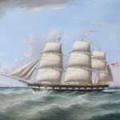Letters to the Editor — Issue 151
Memories of a dear uncle
As Al Norton’s niece, I am so grateful to David Emery for remembering and recreating my uncle’s innovative boat design and to Donnie Mullen for writing about it (Issue #150, “A Design Reborn”).
My grandfather, Al’s father, started the S.B. Norton & Son shipyard. Previously Grandpa Sid had worked on boats for Charles Dana Gibson, who had a summer house on 700 Acre Island. Mr. Gibson was a kind patron to all his employees, including both my grandfather and my Grandma Margaret. After my grandfather’s death, Uncle Al worked long and hard to increase the success of his boatyard. His wife, my Aunt Dorothy, was the business’s bookkeeper.
For me, as a child visiting 700 Acre Island the shipyard was a magical place. My cousin David and I roamed freely everywhere. We played in the many, now abandoned, wooden houses where shipyard workers lived during World War II, as the shipyard workforce grew in response to the nation’s needs. We also went in the airplane hanger-like buildings where the boats were constructed. I marveled at the “railroad tracks” leading down into the water for launching boats.
No matter how busy my uncle was in the summer, he took one day off to take our family in his boat, the Norn, for a picnic on one of the many islands in Penobscot Bay. In the winter my uncle and aunt stayed with us while attending the New York Annual Boat Show.
In retirement my aunt and uncle would travel by boat down the Inland Waterway to “winter” in Florida. They became so used to being on the boat that even after returning to Camden for the summer, they would stay in their house on Mountain Street during the day but sleep on the boat at night. I remember he had a kind of stock market “ticker tape” machine on his boat by which he monitored his investments while traveling.
Thank you so much for honoring my dear uncle. It is so nice to see his deep curiosity about how things worked and innovative ability be remembered.
Nancy Norton Grover Scarborough
Issaquah, WA
A leaky first boat
That runabout on the cover of the January/February issue reminds me of my first boat: a 14' Old Town wooden runabout with a 25 Evinrude engine. It leaked like a sieve each spring when launched.
William Whitman
Deer Isle, ME
Monroe Island preserved
I read Mimi Steadman’s terrific article about Owls Head in your most recent edition with great interest. How appreciative I am of her mentioning Maine Coast Heritage Trust’s effort to conserve Monroe Island and provide an access point on the mainland.
Monroe is a quintessential example of MCHT’s important work to conserve the character of the coast and connect people with the land whenever possible.
A quick good news update on Monroe—the amount left to raise locally is now only $300,000 and there’s a dollar-for-dollar match from The Partridge Foundation to help make that happen by the deadline of May of this year.
We’re excited about what a new Monroe Island preserve will mean for the Owls Head community and those who will love discovering this part of Maine’s coast.
Tim Glidden
President, Maine Coast Heritage Trust
Thanks for the science
The link to Hakai Magazine in the digital version of MBHH is another example of the good things happening at MBHH. I really appreciate the articles that are about science and environment.
I read the article with great interest in part because I’m an aquatic biologist—retired—and because there is no great mystery within the scientific community as to the causes of these toxic algae blooms and so called dead-zones in salt and fresh waters. I did my masters degree work in West-Central Lake Erie in the late 1960s to early 1970s when that body of water was getting national press coverage due to summer fish kills caused by depletion of hypolimnetic (bottom water) dissolved oxygen.
The culprits, of course, are nutrients (nitrogen, phosphorous, potassium, and micro nutrients) from the land, too many people, and the lack of resolve on the part of society to fix the problem. Until we humans decide to limit the introduction of nutrients to fresh and salt waters the problem will only continue.
The costs to society and the environment are mounting, and shoreline communities are at increasing risk in terms of economics and human health. But, again we already know that. That is why the choice of MBHH to publish or provide links to these science and environment articles is so important. They serve as a reminder that we have some serious issues that need to be resolved.
Roy Heberger
Still Landlocked in Boise, ID
New school for mariners
As a mariner from Maine I experience a variety of types of jobs at sea; to be honest my jobs are more like adventures. I am currently the Master of the USNS Salvor, which is anchored over the remains of a WWII U.S. Navy Hellcat fighter that was shot down on 25 July 1944 during an attack on a Japanese seaplane base in Palau. Our bow faces the remains of the Japanese-built seaplane ramp, so we get a feel for the last thing this young man saw.
I am a trustee of the Maine Ocean School in Searsport, which is a new public magnet high school for marine science, technology, transportation, and engineering. I am sharing my experience in the hopes of inspiring others. It is important for our future that we start preparing the young for these marine-related opportunities. That is the goal of the Maine Ocean School because work on the sea is Maine’s greatest work heritage.
Capt. Mike Flanagan
USNS SALVOR T-ARS 52
Merchant Mariner since 1980
Related Articles
Share this article:
2023 Maine Boat & Home Show

Join Us for the Maine Boat & Home Show!
Art, Artisans, Food, Fun & Boats, Boats, Boats
August 11 - 13, 2023 | On the waterfront, Rockland, Maine
Click here to pre-order your tickets.
Show is produced by Maine Boats, Homes & Harbors magazine.















